0.3: Functions
- Page ID
- 131015
\( \newcommand{\vecs}[1]{\overset { \scriptstyle \rightharpoonup} {\mathbf{#1}} } \)
\( \newcommand{\vecd}[1]{\overset{-\!-\!\rightharpoonup}{\vphantom{a}\smash {#1}}} \)
\( \newcommand{\id}{\mathrm{id}}\) \( \newcommand{\Span}{\mathrm{span}}\)
( \newcommand{\kernel}{\mathrm{null}\,}\) \( \newcommand{\range}{\mathrm{range}\,}\)
\( \newcommand{\RealPart}{\mathrm{Re}}\) \( \newcommand{\ImaginaryPart}{\mathrm{Im}}\)
\( \newcommand{\Argument}{\mathrm{Arg}}\) \( \newcommand{\norm}[1]{\| #1 \|}\)
\( \newcommand{\inner}[2]{\langle #1, #2 \rangle}\)
\( \newcommand{\Span}{\mathrm{span}}\)
\( \newcommand{\id}{\mathrm{id}}\)
\( \newcommand{\Span}{\mathrm{span}}\)
\( \newcommand{\kernel}{\mathrm{null}\,}\)
\( \newcommand{\range}{\mathrm{range}\,}\)
\( \newcommand{\RealPart}{\mathrm{Re}}\)
\( \newcommand{\ImaginaryPart}{\mathrm{Im}}\)
\( \newcommand{\Argument}{\mathrm{Arg}}\)
\( \newcommand{\norm}[1]{\| #1 \|}\)
\( \newcommand{\inner}[2]{\langle #1, #2 \rangle}\)
\( \newcommand{\Span}{\mathrm{span}}\) \( \newcommand{\AA}{\unicode[.8,0]{x212B}}\)
\( \newcommand{\vectorA}[1]{\vec{#1}} % arrow\)
\( \newcommand{\vectorAt}[1]{\vec{\text{#1}}} % arrow\)
\( \newcommand{\vectorB}[1]{\overset { \scriptstyle \rightharpoonup} {\mathbf{#1}} } \)
\( \newcommand{\vectorC}[1]{\textbf{#1}} \)
\( \newcommand{\vectorD}[1]{\overrightarrow{#1}} \)
\( \newcommand{\vectorDt}[1]{\overrightarrow{\text{#1}}} \)
\( \newcommand{\vectE}[1]{\overset{-\!-\!\rightharpoonup}{\vphantom{a}\smash{\mathbf {#1}}}} \)
\( \newcommand{\vecs}[1]{\overset { \scriptstyle \rightharpoonup} {\mathbf{#1}} } \)
\( \newcommand{\vecd}[1]{\overset{-\!-\!\rightharpoonup}{\vphantom{a}\smash {#1}}} \)
\(\newcommand{\avec}{\mathbf a}\) \(\newcommand{\bvec}{\mathbf b}\) \(\newcommand{\cvec}{\mathbf c}\) \(\newcommand{\dvec}{\mathbf d}\) \(\newcommand{\dtil}{\widetilde{\mathbf d}}\) \(\newcommand{\evec}{\mathbf e}\) \(\newcommand{\fvec}{\mathbf f}\) \(\newcommand{\nvec}{\mathbf n}\) \(\newcommand{\pvec}{\mathbf p}\) \(\newcommand{\qvec}{\mathbf q}\) \(\newcommand{\svec}{\mathbf s}\) \(\newcommand{\tvec}{\mathbf t}\) \(\newcommand{\uvec}{\mathbf u}\) \(\newcommand{\vvec}{\mathbf v}\) \(\newcommand{\wvec}{\mathbf w}\) \(\newcommand{\xvec}{\mathbf x}\) \(\newcommand{\yvec}{\mathbf y}\) \(\newcommand{\zvec}{\mathbf z}\) \(\newcommand{\rvec}{\mathbf r}\) \(\newcommand{\mvec}{\mathbf m}\) \(\newcommand{\zerovec}{\mathbf 0}\) \(\newcommand{\onevec}{\mathbf 1}\) \(\newcommand{\real}{\mathbb R}\) \(\newcommand{\twovec}[2]{\left[\begin{array}{r}#1 \\ #2 \end{array}\right]}\) \(\newcommand{\ctwovec}[2]{\left[\begin{array}{c}#1 \\ #2 \end{array}\right]}\) \(\newcommand{\threevec}[3]{\left[\begin{array}{r}#1 \\ #2 \\ #3 \end{array}\right]}\) \(\newcommand{\cthreevec}[3]{\left[\begin{array}{c}#1 \\ #2 \\ #3 \end{array}\right]}\) \(\newcommand{\fourvec}[4]{\left[\begin{array}{r}#1 \\ #2 \\ #3 \\ #4 \end{array}\right]}\) \(\newcommand{\cfourvec}[4]{\left[\begin{array}{c}#1 \\ #2 \\ #3 \\ #4 \end{array}\right]}\) \(\newcommand{\fivevec}[5]{\left[\begin{array}{r}#1 \\ #2 \\ #3 \\ #4 \\ #5 \\ \end{array}\right]}\) \(\newcommand{\cfivevec}[5]{\left[\begin{array}{c}#1 \\ #2 \\ #3 \\ #4 \\ #5 \\ \end{array}\right]}\) \(\newcommand{\mattwo}[4]{\left[\begin{array}{rr}#1 \amp #2 \\ #3 \amp #4 \\ \end{array}\right]}\) \(\newcommand{\laspan}[1]{\text{Span}\{#1\}}\) \(\newcommand{\bcal}{\cal B}\) \(\newcommand{\ccal}{\cal C}\) \(\newcommand{\scal}{\cal S}\) \(\newcommand{\wcal}{\cal W}\) \(\newcommand{\ecal}{\cal E}\) \(\newcommand{\coords}[2]{\left\{#1\right\}_{#2}}\) \(\newcommand{\gray}[1]{\color{gray}{#1}}\) \(\newcommand{\lgray}[1]{\color{lightgray}{#1}}\) \(\newcommand{\rank}{\operatorname{rank}}\) \(\newcommand{\row}{\text{Row}}\) \(\newcommand{\col}{\text{Col}}\) \(\renewcommand{\row}{\text{Row}}\) \(\newcommand{\nul}{\text{Nul}}\) \(\newcommand{\var}{\text{Var}}\) \(\newcommand{\corr}{\text{corr}}\) \(\newcommand{\len}[1]{\left|#1\right|}\) \(\newcommand{\bbar}{\overline{\bvec}}\) \(\newcommand{\bhat}{\widehat{\bvec}}\) \(\newcommand{\bperp}{\bvec^\perp}\) \(\newcommand{\xhat}{\widehat{\xvec}}\) \(\newcommand{\vhat}{\widehat{\vvec}}\) \(\newcommand{\uhat}{\widehat{\uvec}}\) \(\newcommand{\what}{\widehat{\wvec}}\) \(\newcommand{\Sighat}{\widehat{\Sigma}}\) \(\newcommand{\lt}{<}\) \(\newcommand{\gt}{>}\) \(\newcommand{\amp}{&}\) \(\definecolor{fillinmathshade}{gray}{0.9}\)Let \(A\) be a set. Then \(A \times A= \{(a_1,a_2)| a_1, a_2 \in A \} \) is the Cartesian product of \(A\).
If \(A = \mathbb{R}\) then this is the Cartesian plane - Like \(\{x,y: x,y \in A\}\).
A function \(f\) is a subset (symbol is \(\subseteq\)) of \(A \times B\) such that for every \(a \in A\) there exists a unique \(b \in B\) such that \(f(a)=b\).
Denoted by \(f: A \rightarrow B\) or \(A \xrightarrow{f} B\).
\(A\) is the domain of the function \(f\).
\(B\) is the co-domain of the function \(f\).
The range of \(f\) is \(f(A)=\big{\{}f(x): x \in A \big{\}} \subseteq B = Im(f)\), the image of \(f.\)
A well-defined function is one that for every value of \(A\), there is one and only one value of \(B\).
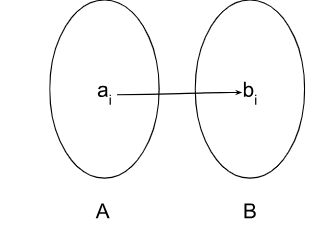
Definition:
Let \(f\) be a function from \(A \rightarrow B\).
-
\(f\) is called onto (surjective) if \(f(A)=B\).
-
\(f\) is called one to one (injective) if \(f(x_1)=f(x_2), x_1,x_2 \in A \) then \(x_1=x_2\).
-
\(f\) is bijective if it is surjective and injective.
-
A function can be injective, surjective, bijective (both injective & surjective), or neither.
Note:
Let \(f: A \rightarrow B\). If \(f\) is 1-1 and onto then \(f\) is a bijection from \(A \rightarrow B.\)
If there is a bijection between two finite sets, the number of elements in each set is the same. Notationally: |A| = |B|.

Consider the mapping:
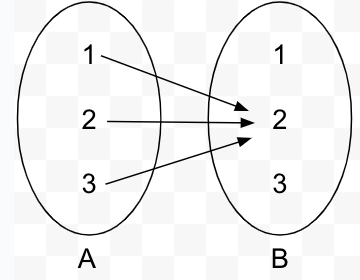
Is this mapping
a) Well defined?
b) Is it surjective?
c) Is it injective?
d) Is it bijective?
Solution
The function is well-defined. Not injective. Not subjective, not bijective.
Consider the mapping:
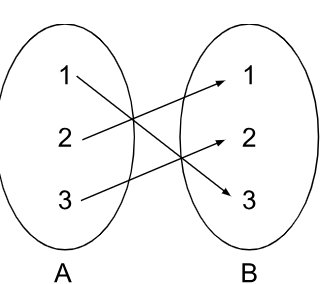
Is this mapping
a) Well defined?
b) Is it surjective?
c) Is it injective?
d) Is it bijective?
Solution
This is well defined bijective function.
Given \(f: \mathbb{Q} \rightarrow \mathbb{Z}\) where \(\mathbb{Q}=\{\frac{a}{b}:a,b \in \mathbb{Z}, b \ne 0 \}\) and \(f(\frac{a}{b})=a\). Is this a well-defined function?
Solution
Let \(A\) and \(B\) be sets such that \(A=\{\frac{a}{b}:a,b \in \mathbb{Z}, a \ne 0\}\) and \(B=\mathbb{Z}\).
Using a counterexample, \(f(\frac{a}{b})\) is not a well-defined function since \(f(\frac{1}{2})=1\) and \(f(\frac{2}{4})=2\), but \(\frac{1}{2}=\frac{2}{4}\). This is an example of an element in \(A\) that maps to more than one element in \(B\).
Example \(\PageIndex{6}\)
Let
\(\mathbb{Q}=\big{\{}\frac{a}{b}: b> 0,\text{and } gcd(a,b)=1 \big{\}}\)
and \(f: \mathbb{Q} \rightarrow \mathbb{Z}\) that is defined by
\(f(\frac{a}{b})=a.\)
a) Is \(f\) a well-defined function? b) Is it surjective? c) Is it injective? d) Is it bijective?
Solution
-
The function is well-defined.
Let \(A\) and \(B\) be set.
Let \(a \in A\).
We need to show that if \(f(a)=b\) then \(b\in B\) and if \(f(a)=b_1\) that \(b=b_1\).
We are given \(f: \mathbb{Q} \rightarrow \mathbb{Z}\), which means that this is a function thus \(f(a)\) will map to one and only one element of \(B\). Thus if \(f(a)=b\) and if \(f(a)=b_1\) then \(b=b_1\).
In b) below, we have shown that the function is surjective, thus \(f(a)=b\),
-
The function is surjective
Proof:
We shall show that \(f(\mathbb{Q})=\mathbb{Z}\) by showing that \(f(\mathbb{Q}) \subseteq \mathbb{Z}\) and \(\mathbb{Z} \subseteq f(\mathbb{Q})\).
Since we are given \(f: \mathbb{Q} \rightarrow \mathbb{Z}\), \(f(\mathbb{Q}) \subseteq \mathbb{Z}\).
Next, we shall show that \(\mathbb{Z} \subseteq f(\mathbb{Q})\).
Let \(n \in \mathbb{Z}\), then \(\frac{n}{1} \in \mathbb{Q}\) and \(f\big(\frac{n}{1}\big)=n\).
Hence \(n \in f(\mathbb{Q})\).
Hence \(\mathbb{Z} \subseteq f(\mathbb{Q})\).
Since \(\mathbb{Z} \subseteq f(\mathbb{Q})\) and \(f(\mathbb{Q}) \subseteq \mathbb{Z}, f(\mathbb{Q})=\mathbb{Z}\).◻
-
The function is not injective.
Counterexample:
Let \(A=\big{\{}\frac{a}{b}: b> 0,\text{and } gcd(a,b)=1 \big{\}}\) and \(B=\mathbb{Z}\).
Note \(\frac{1}{4}, \frac{1}{3} \in A\) and that \(f(\frac{1}{4}), f(\frac{1}{3}) \in B\) and that \(f(\frac{1}{4})=f(\frac{1}{3})=1\).
Since \(\frac{1}{4} \ne \frac{1}{3}\) , the function is not injective.
-
The function is not bijective since it has been shown not to be both injective and surjective.
Operation on functions: Composition
Let \(f: A \rightarrow B\) and \(g: B \rightarrow C\). Then the composition functions of \(g\) and \(f\), \(g \circ f: A \to C \), defined by
\((g \circ f)(a)=g(f(a)), \; \forall a \in A\).
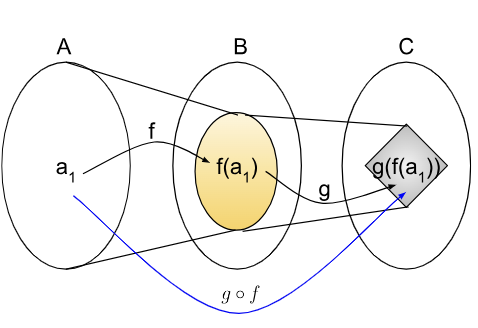
Identity function \(id_A: A \rightarrow A\) defined by \(id_A(x)=x, \forall x \in A\).
Let \(f: A \rightarrow B\) then \(f\) has an inverse \(g: B \rightarrow A\) if \((f \circ g)= id_B\) and \((g \circ f)=id_A\). Note the domain of \(f \circ g\) is the domain of \(g\).
Let \(f:A \rightarrow B\) be a bijection. Then the inverse of \(f\), denoted by \(f^{-1}:B \rightarrow A\) defined by \(f^{-1}(b)=a\) if \(f(a)=b\) if \(a \in A\) and \(b \in B\). In this case, \(f \circ f^{-1}=id_A, \) and \(f^{-1}\circ f =id_B.\)
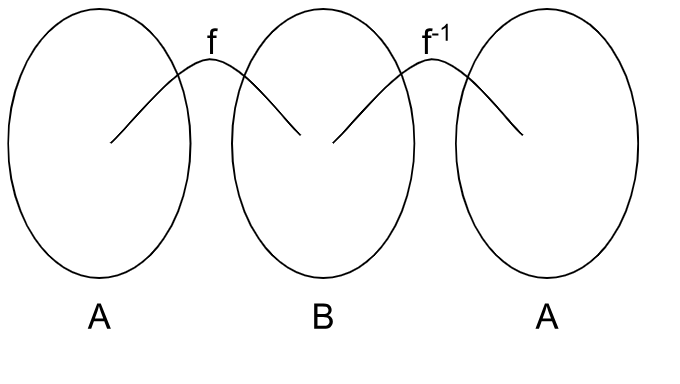
Let \(f: A \rightarrow B\) and \(g: B \rightarrow C\). Then \(g \circ f: A \to C.\)
-
If \(f\) and \(g\) are surjective, then \(g \circ f\) is surjective.
Proof:
We will show that \(g \circ f\) is surjective.
Let \(c \in C\) . Since g is surjective, there exists \(b \in B\) such that \(g(b)=c.\)
Since f is surjective, there exists \(a \in A\) such that \(f(b)=a\).
Hence there exists \(a \in A\) such that \(gf(f(a))=c.\)
Therefore, if \(f\) and \(g\) are surjective, then \(g \circ f\) is surjective.◻
(better proof) If \(f\) is onto and \(g\) is onto then \(g \circ f\) is onto.
Proof:
We shall show that \((g \circ f)(A)=C\).
Since \(f\) and \(g\) are onto, by definition of a function, \((g \circ f)(A) \subseteq C\).
Now we need to show that \(C \subseteq (g \circ f)(A)\).
Let \(c \in C\).
Since \(g\) is onto \(\exists b \in B\) s.t. \(c=g(b)\).
Since \(f\) is onto, \(\exists a \in A\) s.t. \(b=f(a)\).
Consider \((g \circ f)(a)=g(f(a))\) (by definition)
\(=g(b)\)
\(=c\).
Therefore \(c \in (g \circ f)(A)\).
Hence \(C \subseteq (g \circ f)(A)\).
Since \((g \circ f)(A) \subseteq C\) and \(C \subseteq (g \circ f)(A)\), then \(g \circ f\) is onto.◻
-
If \(f\) and \(g\) are injective, then \(g \circ f\) is injective. That is,
If \(f\) is 1-1 and \(g\) is 1-1 then \(g \circ f\) is 1-1.
Proof:
Let \(a_1,a_2 \in A\) such that \(g \circ f (a_1)= g\circ f(a_2).\) Then \(g(f(a_1))=g(f(a_2)).\)
Since \(g\) is 1-1, \(f(a_1)=f(a_2)\).
Since, \(f\) is 1-1, \(a_1=a_2.\)
Hence \(g \circ f\) is injective.
Given \(A\) is a matrix and \(T_A:\mathbb{R}^2 \rightarrow \mathbb{R}^2\) defined by \(T_A \begin{bmatrix} x\\
y\end{bmatrix} = \begin{bmatrix} 1 &1\\
0 & 1\end{bmatrix} \begin{bmatrix} x\\
y\end{bmatrix}\). Note this is a matrix transformation which is linear.
-
Is \(T_A\) 1-1?
Yes, \(T_A\) is 1-1.
Proof:
Let \(\begin{bmatrix} x_1\\
y_1\end{bmatrix}\)and \(\begin{bmatrix} x_2\\
y_2\end{bmatrix} \in \mathbb{R}^2\) s.t. \(T_A \begin{bmatrix} x_1\\
y_1\end{bmatrix} =T_A \begin{bmatrix} x_2\\
y_2\end{bmatrix}\).
We will show that \(\begin{bmatrix} x_1\\
y_1\end{bmatrix} =\begin{bmatrix} x_2\\
y_2\end{bmatrix}\).
\(T_A \begin{bmatrix} x\\
y\end{bmatrix} =\begin{bmatrix} x+y\\
y\end{bmatrix}\).
Thus \(\begin{bmatrix} x_1 +y_1\\
y_1\end{bmatrix} =\begin{bmatrix} x_2+y_2\\
y_2\end{bmatrix}\).
Thus \(x_1+y_1=x_2+y_2\) and \(y_1=y_2\).
Thus \(x_1=x_2\) and \(y_1=y_2\).
Hence \(\begin{bmatrix} x_1\\
y_1\end{bmatrix} =\begin{bmatrix} x_2\\
y_2\end{bmatrix}\).
Thus \(T_A\) is 1-1.◻
-
Is \(T_A \begin{bmatrix} x\\
y\end{bmatrix} \) onto?
Yes, \(T_A \begin{bmatrix} x\\
y\end{bmatrix} \) is onto.
Proof:
We know by definition that \(T_A \begin{bmatrix} x\\
y\end{bmatrix} \subseteq \mathbb{R}^2\).
We need to show that \(\mathbb{R}^2 \subseteq T_A \begin{bmatrix} x\\
y\end{bmatrix}\).
Let \( \begin{bmatrix} a\\
b\end{bmatrix} \in \mathbb{R}^2\).
Find \( \begin{bmatrix} x\\
y\end{bmatrix} \in \mathbb{R}^2\) s.t. \(\begin{bmatrix} 1 &1\\
0 & 1\end{bmatrix} \begin{bmatrix} x\\
y\end{bmatrix}=\begin{bmatrix} a\\
b\end{bmatrix}\).
\(\begin{bmatrix} x+y\\
y\end{bmatrix} =\begin{bmatrix} a\\
b\end{bmatrix}\).
Thus \(y=b\) and \(x=a-b\).
Thus \(T_A \begin{bmatrix} a-b\\
b\end{bmatrix} =\begin{bmatrix} a\\
b\end{bmatrix}\).
Thus \(T_A\) is onto.◻
-
Does \(T_A\) have an inverse? If so, what is it?
a) Yes \(T_A\) has an inverse since it is a bijection (1-1 and onto) ∴ \(T_A^{-1}\) exists.
Proof: By definition? Obvious?
b) \(T_A^{-1}: \mathbb{R}^2 \rightarrow \mathbb{R}^2\).
\(T_A^{-1} \begin{bmatrix} x\\
y\end{bmatrix} =\begin{bmatrix} 1 & -1\\
0 & 1\end{bmatrix} \begin{bmatrix} x\\
y\end{bmatrix}\)
\(=\begin{bmatrix} x-y\\
y\end{bmatrix} \).
Check: \( T_A^{-1} \cdot T_A=\begin{bmatrix} 1 & -1\\
0 & 1 \end{bmatrix} \cdot \begin{bmatrix} 1 & 1\\
0 & 1\end{bmatrix} =\begin{bmatrix} 1 & 0\\
0 & 1 \end{bmatrix}\).
Let \(f: A \rightarrow B\) and \(g: B \rightarrow C\). Then \(g \circ f:A \to C\) . Given \(g \circ f\) is injective and \(f\) is onto, prove that \( g\) is injective.
Proof:
Assume \(g \circ f\) is injective. (by definition)
Let \(x_1, x_2 \in B\) s.t. \(g(x_1)=g(x_2)\).
We shall show that \(x_1=x_2\).
Let \(a_1, a_2 \in A\).
Since \(f\) is surjective (by definition), we know that \(f(a_1)=x_1\) and \(f(a_2)=x_2\).
Since \(x_1 \in B\) and \(f\) is surjective, \(\exists a_1 \in A\) s.t. \(f(a_1)=x_1\).
Since \(x_2 \in B\) and \(f\) is surjective, \(\exists a_2 \in A\) s.t. \(f(a_2)=x_2\).
Since \(g(x_1)=g(x_2)\), then \(g(f(a_1))=g(f(a_2))\) and \(g \circ f)(a_1)=(g \circ f)(a_2)\).
Since \(g \circ f)\) is injective, \(a_1=a_2\).
Thus \(f(a_1)=f(a_2)\) since \(f\) is a function.
Therefore, \(x_1=x_2\).
Hence \(g\) is injective.
Consider the mapping \(\alpha\):

Find \(\alpha^2\) , \(\alpha^3\) and \(\alpha^{-1}\).


